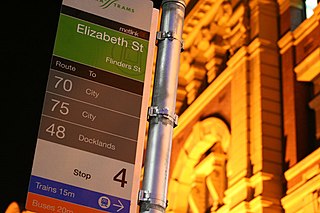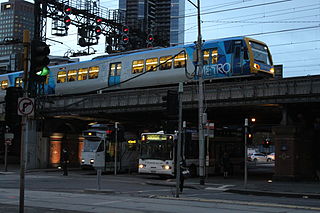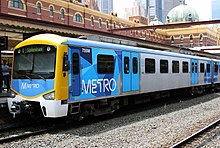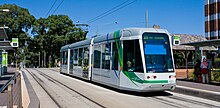
Metlink was the marketing body and umbrella brand for public train, tram and bus transport operators in Melbourne, Australia. On 2 April 2012, the operations of Metlink were transferred to the newly created public transport planning and management authority, Public Transport Victoria.

Transport in Melbourne, the state capital of Victoria, Australia, consists of several interlinking modes. Melbourne is a hub for intercity, intracity and regional travel. Road-based transport accounts for most trips across many parts of the city, facilitated by Australia's largest freeway network. Public transport, including the world's largest tram network, trains and buses, also forms a key part of the transport system. Other dominant modes include walking, cycling and commercial-passenger vehicle services such as taxis.
VicRoads is a government joint venture in the state of Victoria, Australia. In the state, it is responsible for driver licensing and vehicle registration. It is owned and operated through a joint venture between the Victorian government and a consortium made up of Aware Super, Australian Retirement Trust and Macquarie Asset Management.

Lynne Janice Kosky was an Australian politician and senior minister in the Government of Victoria. She represented the electoral district of Altona in the Victorian Legislative Assembly for the Labor Party from 1996 to 2010 and held key ministerial posts from 1999 through to her retirement from politics, including the key education and public transport portfolios.
Transport law is the area of law dealing with transport. The laws can apply very broadly at a transport system level or more narrowly to transport things or activities within that system such as vehicles, things and behaviours. Transport law is generally found in two main areas:

The Transport Integration Act 2010 is a law enacted by the Parliament of the State of Victoria, Australia. The Act is the prime transport statute in Victoria, having replaced major parts of the Transport Act 1983, which was renamed as the Transport Act 1983.

The Transport Legislation Review is a policy and legislation review project conducted by the Department of Transport in the State of Victoria, Australia between 2004 and late 2010. The aim of the project was review of transport policy and laws and generation of new policy and legislation as a platform for better transport across the State.

The Rail Safety Act 2006 is a law enacted by the Parliament of the State of Victoria, Australia, and is the prime statute regulating the safety of rail operations in Victoria. The Act was developed as part of the Transport Legislation Review conducted by the Department of Transport between 2004 and 2010 and is aimed at preventing deaths and injuries arising from rail operations.

The Director of Public Transport was the head of the Public Transport Division (PTD) of the Victorian Department of Transport. PTD was the government agency responsible for promoting, providing, coordinating and regulating public transport in the state of Victoria, Australia between August 1999 and June 2013. The Director of Public Transport was created as a statutory office supported by staff of the Department of Transport.

The Tourist and Heritage Railways Act 2010 is a law enacted by the Parliament of the State of Victoria, Australia and is the prime statute regulating the activities of tourist and heritage rail operators in the State. The Act covers the bulk of Victoria's operational tourist and heritage railways including many heavy and light rail operations and tramways, predominantly in regional areas of Victoria.
The Director, Transport Safety, who operates as Transport Safety Victoria, is the independent Government agency responsible for bus and marine safety in the State of Victoria, Australia. The position was created as a statutory office by the Transport Integration Act 2010 and the office commenced operation on 1 July 2010. The Rail branch of TSV completed transfer to the Office of the National Rail Safety Regulator (ONRSR) in December 2019.
The Director, Public Transport Safety was the independent Government agency responsible for rail and bus safety in the State of Victoria, Australia, between 1 August 2006 and 30 June 2010. The position was created as a statutory office by statute in early 2006 and was the State's first independent public transport safety position. The office was superseded by the position of the Director, Transport Safety which commenced operation on 1 July 2010. The former Safety Director, Public Transport Safety, Alan Osborne, was directly appointed to the new office.
The Chief Investigator, Transport Safety is the independent Government agency responsible for investigation of safety-related trends and incidents in the rail, bus and marine industries in the State of Victoria, Australia.
Public Transport Victoria (PTV) is the brand name for public transport in the Australian state of Victoria. It was previously the trading name of the Public Transport Development Authority (PTDA), a now-defunct statutory authority in Victoria, responsible for providing, coordinating, and promoting public transport.

Commercial Passenger Vehicles Victoria (CPVV), until 2 June 2018 called the Taxi Services Commission (TSC), is the Government agency responsible for the regulation of the taxi and hire car industries in the State of Victoria, Australia. Before becoming a regulator, the TSC was responsible for conducting a major independent inquiry, the Taxi Industry Inquiry, into taxi and other small commercial passenger vehicle services in the State.
The Transport Act 1983 was the main statute establishing government transport organisations and regulating land transport activities in the State of Victoria, Australia for 27 years from mid-1983 to mid-2010. The act was used as the vehicle for changes to transport organisational arrangements and transport regulation activities pursued by Victorian governments over that period.

The Transport Act 1983 is a prime statute regulating transport activities in the State of Victoria, Australia. Key areas regulated by the statute currently include taxi and hire car services and compliance and enforcement, particularly in areas like safety and public transport ticketing and conduct.
Transport for Victoria is a statutory office of the Department of Transport that is responsible for the planning and coordination of all transport systems in Victoria, Australia.
The Department of Transport and Planning (DTP) is a government department in Victoria, Australia. Commencing operation on 1 January 2019 as the Department of Transport (DOT), the DOT was formed in machinery of government changes made by Premier Daniel Andrews after the re-election of his Labor government at the 2018 Victorian state election. The re-shuffle saw the "super-ministry" Department of Economic Development, Jobs, Transport and Resources abolished and its functions reassigned to the DOT and Department of Jobs, Precincts and Regions.
















